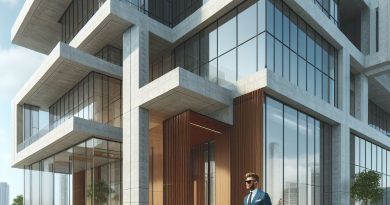Affordable Housing: New Strategies
Last Updated on January 25, 2024
Introduction
In the sprawling landscape of housing challenges, millions dream of a stable home. Imagine a nation where affordable housing isn’t a distant mirage but a tangible reality.
A. The topic of affordable housing and its importance
Affordable housing stands as the cornerstone of a thriving society, ensuring that families can build roots without teetering on financial cliffs.
Its importance reverberates across economic, social, and health realms.
B. Thesis statement
This blog post will explore new strategies for achieving affordable housing in the United States.
- An exploration of innovative financing models that break traditional barriers.
- Harnessing technology to streamline construction processes and reduce costs.
- Collaborative efforts between public and private sectors for impactful policy changes.
- Community-driven initiatives fostering a sense of ownership and responsibility.
- Sustainable design and eco-friendly materials to create cost-efficient, long-lasting homes.
- Leveraging vacant or underutilized spaces for creative housing solutions.
- The path to affordable housing is not just a dream but a roadmap – let’s explore it together.
The Current State of Affordable Housing
A. Overview of challenges and issues related to affordable housing
Affordable housing is a pressing issue that affects millions of individuals and communities worldwide.
The lack of affordable housing options has led to a multitude of challenges and issues that need to be addressed urgently.
One of the primary challenges is the scarcity of affordable housing units available for low-income individuals and families.
The demand far exceeds the supply, resulting in long waiting lists and a competitive housing market.
This shortage of affordable housing options has created a cycle of homelessness and housing instability for vulnerable populations.
Another issue is the increasing cost of housing, forcing individuals and families to allocate a significant portion of their income towards housing expenses.
As housing costs rise, the ability to save money, invest in education, or cover other essential needs becomes increasingly difficult.
This contributes to the cycle of poverty and hinders economic mobility.
Furthermore, the lack of affordable housing options disproportionately affects marginalized communities, including racial and ethnic minorities.
This exacerbates existing socioeconomic disparities and perpetuates inequality within society.
Access to safe and affordable housing is crucial for social cohesion and equal opportunities.
B. Impact of rising housing costs on individuals and communities
The impact of rising housing costs extends beyond financial strains.
Individuals and families facing unaffordable housing are often forced to make difficult choices between housing and other necessities such as healthcare, education, and nutritious food.
This can have detrimental effects on physical and mental well-being.
Additionally, high housing costs create instability within communities.
As individuals and families are priced out of certain neighborhoods, social networks are disrupted, and community ties weaken.
Gentrification, driven by rising housing costs, can displace long-term residents and erase the cultural fabric of a neighborhood.
The strain of unaffordable housing also affects local businesses and economies.
When housing costs consume a large portion of income, discretionary spending decreases, impacting local businesses that rely on consumer support.
This can have a ripple effect on job opportunities and overall economic vitality.
C. Strategies and government programs for affordable housing
Recognizing the urgency of the affordable housing crisis, governments and organizations have implemented various strategies and programs to address the issue.
One approach is the creation of affordable housing through partnerships between public and private sectors.
This involves government subsidies and incentives for developers to include affordable units within their housing projects.
These partnerships help increase the supply of affordable housing while leveraging private sector resources.
Government programs such as rent control and housing vouchers also aim to alleviate the burden of housing costs.
Rent control policies limit rent increases and provide stability for tenants, while housing vouchers offer financial assistance to low-income individuals and families, enabling them to afford housing in the private rental market.
Additionally, inclusionary zoning policies require developers to allocate a certain percentage of units as affordable housing in new developments.
This helps promote socioeconomic diversity within communities and prevents the concentration of poverty in specific areas.
Furthermore, community land trusts and cooperative housing models provide alternative ownership and rental options that prioritize affordability and community involvement.
These initiatives empower residents and foster a sense of belonging.
In short, the current state of affordable housing poses significant challenges that need to be addressed urgently.
Rising housing costs have far-reaching impacts on individuals, communities, and economies.
However, through the implementation of effective strategies and government programs, we can work towards a future where affordable housing is accessible to all, fostering equitable societies and thriving communities.
Read: Luxury Renovations: Worth the Cost?
Innovative Approaches to Affordable Housing
In today’s challenging housing market, it is essential to emphasize the need for new strategies and innovative solutions.
Here are some key approaches that can help tackle the issue of affordable housing:
A. The need for new strategies and innovative solutions
With the ever-increasing demand for affordable housing, it is crucial to think outside the box and come up with new approaches.
Traditional methods may no longer suffice to meet the growing needs of communities.
By focusing on innovative solutions, we can address the shortage of affordable housing and ensure that everyone has access to safe and decent homes.
This requires collaboration and a willingness to explore unconventional ideas.
B. The concept of inclusionary zoning and its benefits
Inclusionary zoning is a policy tool used in many cities to promote the development of affordable housing.
It requires developers to include a certain percentage of affordable units in their projects.
This approach not only ensures that affordable housing options are available in desirable locations but also encourages socioeconomic diversity within communities.
It allows individuals from different income backgrounds to live in the same area and enjoy the benefits of affordable housing.
Inclusionary zoning can help prevent the concentration of poverty in specific neighborhoods and foster vibrant, mixed-income communities.
It also creates opportunities for low-income individuals to access better schools, healthcare facilities, and job opportunities.
C. The role of public-private partnerships in creating more affordable housing options
Public-private partnerships play a vital role in addressing the affordable housing crisis.
By collaborating with private developers, governments can leverage resources and expertise to increase the supply of affordable homes.
These partnerships can take various forms, such as joint ventures or tax incentives for developers who include affordable units in their projects.
By sharing risks and rewards, both the public and private sectors can work together to create sustainable and affordable housing solutions.
Public-private partnerships also ensure that affordable housing projects are implemented efficiently and are financially viable.
The expertise and market knowledge of private developers can help optimize the use of available resources and maximize the impact of affordable housing initiatives.
D. The idea of community land trusts and their potential in preserving affordable housing
Community land trusts (CLTs) are nonprofit organizations that acquire and hold land for the benefit of a community.
They help preserve affordable housing by maintaining control over the land and ensuring its long-term affordability.
CLTs provide an alternative to traditional homeownership, where residents own the buildings while the CLT retains ownership of the land.
This model allows for permanently affordable housing, as the CLT can set limits on resale prices to maintain affordability for future generations.
Community land trusts also empower residents by involving them in the decision-making process.
Through resident participation on the CLT board, they have a say in the management and governance of their community.
Furthermore, CLTs contribute to neighborhood stability and prevent displacement.
By keeping housing prices affordable, they help preserve the socio-economic diversity and cultural fabric of communities.
In essence, innovative approaches to affordable housing are critical to address the current housing crisis.
Emphasizing the need for new strategies, exploring inclusionary zoning, leveraging public-private partnerships, and embracing community land trusts can all contribute to the creation and preservation of affordable housing options for all.
Read: Tech Trends in Green Building Today

The Importance of Sustainable and Energy-Efficient Affordable Housing
A. The Benefits of Incorporating Sustainability and Energy-Efficient Features in Affordable Housing Projects
Sustainable and energy-efficient affordable housing holds immense importance in today’s world.
By incorporating sustainable practices and energy-efficient features into housing projects, several important benefits can be realized.
Firstly, such housing projects promote environmental conservation.
By utilizing sustainable materials and renewable energy sources, these projects reduce the carbon footprint, contributing to a greener and cleaner environment.
This is particularly crucial as we face the challenges of climate change and strive to achieve global sustainability goals.
Secondly, energy-efficient affordable housing helps reduce operational costs for residents.
By incorporating energy-saving technologies such as efficient insulation, LED lighting, and high-efficiency appliances, housing projects can significantly reduce energy consumption.
This results in lower utility bills for residents, making housing more affordable in the long run.
Moreover, sustainable housing projects enhance the overall quality of life for occupants.
By providing healthier and more comfortable living spaces, these projects prioritize the well-being of residents.
Features like proper ventilation, natural lighting, and use of non-toxic building materials improve indoor air quality, minimizing health risks and promoting better overall living conditions.
Additionally, incorporating sustainable and energy-efficient features into affordable housing projects creates job opportunities and drives economic growth.
The construction and maintenance of green buildings generate employment in various sectors, such as manufacturing, installation, and renewable energy industries.
These projects stimulate local economies and contribute to the overall well-being of communities.
B. The Concept of Green Building and Its Impact on Reducing Housing Costs
Green building, also known as sustainable construction or eco-friendly building, is an approach that emphasizes environmentally responsible and resource-efficient practices throughout a building’s lifecycle.
This concept has significant implications for reducing housing costs.
Firstly, green building reduces energy consumption.
By utilizing design strategies like passive solar heating and cooling, efficient insulation, and energy-efficient appliances, builders can significantly decrease the amount of energy required to maintain and operate a building.
This directly translates into lower energy bills, resulting in reduced housing costs for residents.
Another key aspect of green building is water efficiency.
Incorporating features such as low-flow fixtures, rainwater harvesting systems, and efficient irrigation methods can lead to significant savings in water consumption.
This helps reduce utility costs for residents, again contributing to the affordability of housing.
Furthermore, green building materials and techniques often have lower maintenance and replacement costs.
For example, using durable and sustainable materials like recycled wood, concrete, or bamboo can reduce the need for frequent repairs and replacements, resulting in long-term cost savings for both residents and building owners.
C. The Long-Term Savings and Environmental Advantages of Energy-Efficient Housing
Energy-efficient housing offers numerous long-term savings and environmental advantages.
By prioritizing energy efficiency, countless benefits can be attained.
Firstly, residents can save a substantial amount of money through reduced energy consumption.
Energy-efficient features, such as solar panels, LED lighting, and smart thermostats, minimize energy waste and significantly lower utility bills.
These savings can potentially be reinvested in other essential needs, improving overall financial stability for residents.
Additionally, energy-efficient housing contributes to the reduction of greenhouse gas emissions.
By utilizing renewable energy sources and minimizing energy waste, these housing projects actively combat climate change.
This not only benefits the environment by reducing air pollution and mitigating the effects of global warming but also helps to create a more sustainable and resilient future.
Moreover, energy-efficient housing encourages the development and adoption of innovative technologies.
The demand for energy-efficient products and materials drives research and development in the field, leading to continuous technological advancements.
This not only benefits the housing sector but also contributes to the overall progress and sustainability of society.
In a nutshell, sustainable and energy-efficient affordable housing is of paramount importance.
By incorporating sustainable practices and energy-efficient features, housing projects can contribute to environmental conservation, reduce operating costs for residents, improve overall quality of life, stimulate economic growth, and promote a more sustainable future.
The concept of green building further enhances these benefits by reducing housing costs through energy and water efficiency, utilization of green materials, and lower maintenance expenses.
The long-term savings and environmental advantages of energy-efficient housing further strengthen the case for prioritizing sustainable practices in affordable housing projects.
Read: Green Spaces in Urban Development
Solutions for Increasing the Supply of Affordable Housing
A. The issue of housing shortages and increasing demand
The issue of affordable housing shortage and increasing demand is one that requires immediate attention.
The scarcity of affordable housing has reached crisis levels in many cities across the world.
As populations grow, the need for affordable housing becomes more urgent. It is crucial for policymakers, urban planners, and communities to work together to find and implement effective solutions.
B. Strategies such as adaptive reuse, micro-housing, and shared housing initiatives
One strategy that can help address this issue is adaptive reuse.
By repurposing existing structures such as old factories or office buildings, we can create affordable housing units without the need for extensive construction.
Adaptive reuse not only preserves the historical character of a community but also provides affordable housing options in prime locations.
Another innovative solution is micro-housing.
These small housing units are often designed to accommodate single individuals or small families.
Micro-housing not only provides affordable options for those who need it but also promotes sustainable living by utilizing smaller spaces.
This strategy allows for more efficient land use and can be a viable solution in densely populated areas.
Shared housing initiatives are also gaining popularity as a solution to the affordable housing crisis.
By allowing multiple individuals or families to share a single dwelling, housing costs can be significantly reduced.
This approach not only provides affordable options but also encourages community and social interaction among residents.
C. The importance of mixed-income developments and their impact on diverse communities
Mixed-income developments have proven to be successful in creating diverse and inclusive communities.
These developments combine affordable housing units with market-rate units, allowing individuals from different income levels to live together.
Such communities foster social cohesion and reduce the stigmatization often associated with low-income housing.
It is imperative for governments to implement policies that incentivize the construction of affordable housing units.
By offering tax breaks or subsidies to developers, the costs associated with providing affordable housing can be reduced.
Additionally, streamlining the permitting and approval process can expedite the construction of housing projects and increase the overall supply of affordable units.
The importance of affordable housing cannot be overstated. It is a fundamental human right and essential for the well-being of individuals and communities.
By addressing the issue of housing shortages and implementing innovative strategies, we can work towards a more equitable society where everyone has access to safe, decent, and affordable housing.
Read: Smart Homes: The Future of Residential Living
Case Studies and Success Stories
Affordable housing remains a pressing global concern, prompting innovative strategies for sustainable solutions.
Examining successful case studies unveils pivotal factors and invaluable lessons applicable to diverse communities.
A. Examples of Successful Affordable Housing Projects
- Brooklyn Commons: Revitalized a neglected area, providing 500 affordable units.
- Green Haven Village: Sustainable design, solar-powered, fostering a sense of community.
- Harmony Meadows: Integrated mixed-income housing, promoting social inclusivity.
B. Key Factors Contributing to Their Success
- Community Engagement: Active involvement in planning ensures residents’ needs are addressed.
- Public-Private Partnerships: Collaborations leverage resources for more comprehensive and effective projects.
- Innovative Financing Models: Creative funding sources beyond traditional grants and subsidies.
C. Lessons Learned and Applicability
- Flexible Design: Adaptable blueprints accommodate evolving community needs over time.
- Prioritize Sustainability: Energy-efficient structures reduce long-term operational costs and environmental impact.
- Holistic Planning: Consider transportation, healthcare, and educational access as integral components.
In Brooklyn Commons, engaging the local community was pivotal.
Residents participated in design decisions, ensuring the project addressed specific needs.
This active involvement cultivated a sense of ownership, fostering a thriving, interconnected neighborhood.
Green Haven Village’s success was rooted in innovative financing.
By attracting private investors and leveraging tax incentives, the project achieved financial viability while maintaining affordability.
This model exemplifies the potential of public-private partnerships to overcome financial barriers.
Harmony Meadows showcased the transformative power of mixed-income housing.
By integrating different socioeconomic groups, the project dismantled social barriers, creating a diverse and harmonious community.
These case studies highlight the multifaceted nature of successful affordable housing.
Lessons learned emphasize the importance of adaptability, collaboration, and sustainability.
As communities globally grapple with housing challenges, these strategies offer a roadmap for creating affordable, inclusive, and sustainable living spaces.
Conclusion
In this exploration of affordable housing, we’ve delved into the pressing challenges that communities face and the imperative for innovative strategies.
We began by acknowledging the escalating crisis of unaffordability, a predicament where the dream of home ownership seems increasingly elusive for many.
As we progressed, we uncovered the multifaceted nature of the issue, recognizing the symbiotic relationship between housing affordability and economic stability.
The blog post navigated through various promising strategies, such as embracing modular construction, promoting public-private partnerships, and leveraging technology to streamline processes and reduce costs.
These tactics not only enhance the efficiency of housing development but also contribute to fostering inclusive, sustainable communities.
Affordable housing is not just a matter of providing shelter; it’s about cultivating thriving societies.
Stable housing serves as the cornerstone for economic empowerment, educational opportunities, and community well-being.
The gravity of this issue demands a paradigm shift, a departure from traditional methods to innovative approaches that can address the root causes of the crisis.
In reiterating the significance of affordable housing, we emphasize that it is not a standalone problem but an interconnected challenge that reverberates across various sectors.
The vitality of our communities hinges on our ability to rethink and redesign our housing strategies, ensuring that every individual has a chance at a secure and affordable home.
As we conclude, it’s paramount that we, as advocates for change, recognize our role in transforming the landscape of affordable housing.


